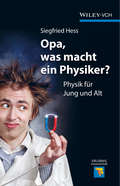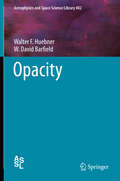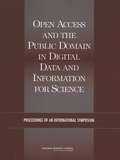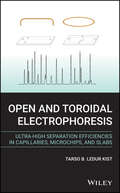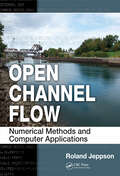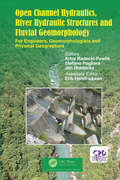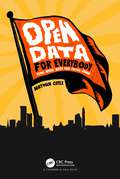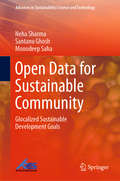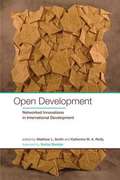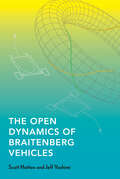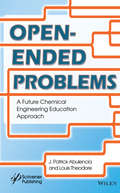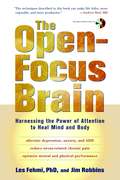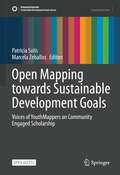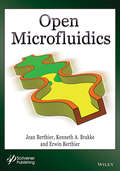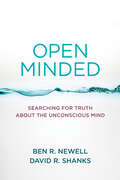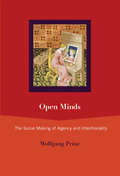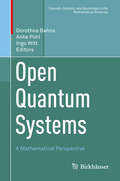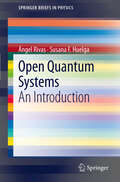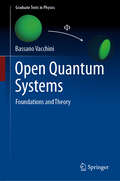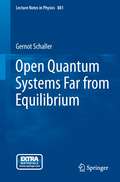- Table View
- List View
Oorjjathanthram class 10 Malayalam Medium - SCERT Board: ഊര്ജ്ജതന്ത്രം മലയാളം മീഡിയം ക്ലാസ് 10 എസ്.ഇ.ആര്.ടി ബോര്ഡ്
by State Council of Educational Research and TrainingYou were provided with opportunities to observe your surroundings and engage in simple experiments and investigative activities in earlier classes. The classroom experience, undoubtedly, might have helped you to record the information systematically and assimilate ideas through discussion and analysis. While understanding the scientific approach, there should also be the attitude to take forward the skills to apply them in day-to-day life. Moreover, an eco-friendly perspective must be adopted too. All these, through direct experiences, enquiry and understanding preferably. This textbook presents ideas in accordance with this.
Opa, was macht ein Physiker?: Physik für Jung und Alt
by Siegfried HessWas für eine schöne Idee! Siegfried Hess erklärt allen Menschen ab 10 Jahren, was die Welt im Innersten zusammenhält und was die Physik damit zu tun hat. Die Grundlagen dafür beginnen mit der Mechanik.<P><P> Wussten Sie, dass es eine himmlische, eine irdische und eine höllische Mechanik gibt? Die himmlische Mechanik erklärt die Bewegung der Erde um die Sonne und die des Mondes um die Erde. Die irdische beschäftigt sich mit der Mechanik auf der Erde - u. a. mit Rädern, Hebeln, dem Fliegen oder Reibung und Bewegungen, und die höllische Mechanik schließlich behandelt den Flug und die Wirkung von Kanonenkugeln und anderen Geschossen. FORSCHER UND IHRE ENTDECKUNGEN: VON HEINRICH HERTZ BIS ZU MAX PLANCK Was die klassische Mechanik nicht erklären kann - die Physik der Atome und Moleküle und ihre Wechselwirkung mit Licht -, das erklärt die Quantenmechanik. Hess stellt - wie auch schon zuvor - Forscher und Entdecker vor und bringt den Lesern so das Gebiet der Quantenmechanik nahe. Wer eine Auflockerung dazwischen braucht, der kann sich mit dem >TeekesselspielWas wäre, wenn an der Planck-Konstanten gedreht wird?< lesen. Mitwirkende: Albert Einstein, Max Planck und Max von Laue und viele andere ? frei erfunden von Siegfried Hess.
Opacity
by Walter F. Huebner W. David BarfieldThis book covers all aspects of opacity and equations of state for gases, plasmas, and dust. The discussion emphasizes the continuous transformation of the equilibrium compositions of these phases as a function of temperature and density.
Open Access And The Public Domain In Digital Data And Information For Science: Proceedings Of An International Symposium
by Julie M. Esanu U.S. National Committee for CODATA National Research Council Staff Paul F. UhlirThis symposium, which was held on March 10-11, 2003, at UNESCO headquarters in Paris, brought together policy experts and managers from the government and academic sectors in both developed and developing countries to (1) describe the role, value, and limits that the public domain and open access to digital data and information have in the context of international research; (2) identify and analyze the various legal, economic, and technological pressures on the public domain in digital data and information, and their potential effects on international research; and (3) review the existing and proposed approaches for preserving and promoting the public domain and open access to scientific and technical data and information on a global basis, with particular attention to the needs of developing countries.
Open and Toroidal Electrophoresis: Ultra-High Separation Efficiencies in Capillaries, Microchips and Slabs
by Tarso B. Ledur KistPresents the theory and applications of Toroidal Capillary, Microchip, and Slab Electrophoresis to analytical chemists across a range of disciplines Written by one of the developers of Toroidal Capillary Electrophoresis (TCE), this book is the first to present this novel analytical technique, in detail, to the field of analytical chemistry. The exact expressions of separation efficiency, resolution, peak capacity, and many other performance indicators of the open and toroidal layouts are presented and compared. Featuring numerous illustrations throughout, Open and Toroidal Electrophoresis: Ultra-High Separation Efficiencies in Capillaries, Microchips and Slabs offers chapters covering: Solvents and Buffer Solutions; Fundamentals of Electrophoresis; Open Layout; and Toroidal Layout. Confronting Performance Indicators is next, followed by chapters on High Voltage Modules and Distributors; Heat Removal and Temperature Control; and Detectors. The book finishes with an examination of the applications of Toroidal Electrophoresis. The first book to offer a detailed account of Toroidal Electrophoresis—written by one of its creators Compares the toroidal layouts with the well-established open layouts of the three most used platforms (Capillary, Microchip, and Slab) Provides solutions to many of the experimental issues arising in electromigration techniques and discusses the voltage distributors and detectors that are compatible with the toroidal layouts Richly illustrated with a large number of useful equations showing the relationships between important operational parameters and the performance indicators Open and Toroidal Electrophoresis is aimed at method developers and separation scientists working in clinical analysis, and food analysis, as well as those in pharmacology, disease biomarker applications, and nucleic acid analysis using the Capillary, Microchip, or slab Platform. It will also benefit undergraduate and graduate students of inorganic analytical chemistry, organic analytical chemistry, bioanalysis, pharmaceutical sciences, clinical sciences, and food analysis.
Open Channel Flow: Numerical Methods and Computer Applications
by Roland JeppsonA comprehensive treatment of open channel flow, Open Channel Flow: Numerical Methods and Computer Applications starts with basic principles and gradually advances to complete problems involving systems of channels with branches, controls, and outflows/ inflows that require the simultaneous solutions of systems of nonlinear algebraic equations coupled with differential equations. The book includes downloadable resources that contain a program that solves all types of simple open channel flow problems, the source programs described in the text, the executable elements of these programs, the TK-Solver and MathCad programs, and the equivalent MATLAB® scripts and functions.The book provides applied numerical methods in an appendix and also incorporates them as an integral component of the methodology in setting up and solving the governing equations. Packed with examples, the book includes problems at the end of each chapter that give readers experience in applying the principles and often expand upon the methodologies use in the text. The author uses Fortran as the software to supply the computer instruction but covers math software packages such as MathCad, TK-Solver, MATLAB, and spreadsheets so that readers can use the instruments with which they are the most familiar. He emphasizes the basic principles of conservation of mass, energy, and momentum, helping readers achieve true mastery of this important subject, rather than just learn routine techniques. With the enhanced understanding of the fundamental principles of fluid mechanics provided by this book, readers can then apply these principles to the solution of complex real-world problems. The book supplies the knowledge tools necessary to analyze and design economical and properly performing conveyance systems. Thus not only is the book useful for graduate students, but it also provides professional engineers the expertise and knowledge to design well performing and economical channel systems.
Open Channel Hydraulics, River Hydraulic Structures and Fluvial Geomorphology: For Engineers, Geomorphologists and Physical Geographers
by Artur Radecki-Pawlik Stefano Pagliara Jan HradeckyThis book presents practical hydraulic and river engineering research along with fluvial geomorphological concepts, and links the theoretical and practical knowledge of people working every day with rivers, streams, and hydraulic structures to fluvial geomorphology. Besides providing a guide for professionals, this book also provides material for students to acquire the knowledge and skills to rehabilitate rivers, streams, and waterways.
Open Data for Everybody: Using Open Data for Social Good
by Nathan CoyleWhat if I told you something that could empower our third sector and activists to enhance their capacity? From gathering evidence for funding tenders to campaigning for crucial social issues and much more? It's called open data, yet many in social action remain unaware of it. Primarily shaped by corporate entities, open data seems tailored only for technologists, alienating the third sector. But in reality, it's a powerful tool for social change, bolstering civil society, and creating resilient communities.This book argues a simple point: if open data and the digital aspects that support it aren't accessible to all, then what is the point of it? In an age where technology should be seen as a fundamental human right, it's time to rethink outreach. Deeply rooted in grassroots social activism, this book explores a journey that led to collaborations with governments globally, based on real hands-on work, aiming to democratize open data. Through narrative storytelling, we share insights, best practices, procedures, and community-driven approaches. Regardless of your skill set or organization size, from grassroots workers to third-sector professionals and government officers, join us to reshape the perception of open data, fostering change in neighborhoods.Open Data for Everybody: Using Open Data for Social Good is a love letter to open data's transformative power. To create solutions, understanding the problem is crucial. This book seeks to return control to the real experts—those living and working within our communities.
Open Data for Sustainable Community: Glocalized Sustainable Development Goals (Advances in Sustainability Science and Technology)
by Neha Sharma Santanu Ghosh Monodeep SahaThis book is an attempt to bring value to the enterprise pursuits in the areas of research and innovation around the specific issues in terms of topic selection, open data resources and researcher orientation. Over the last 300 years, industrial revolutions have had game-changing impact on societies. Presently, by and large, we are at the crossroads of the fourth industrial revolution, where phygital systems are going to play a massive role, where digital systems can simulate and go beyond the limitations of the physical world, thereby enabling a new world order. This transformation is cutting across every sphere known to mankind. The world will become a globally localized marketplace. In today’s business world, sustainability is a corporate agenda. Enterprises are also aiming to be purpose-driven, adaptive and resilient to disruptions. The contributions to community and environment are part of their corporate branding. The book explores and presents a part of the open data sets from government institutions to achieve the sustainable goals at local level, in turn contributing towards global mission. As the topic suggests, the authors are looking at some of the specific issues in the areas of environment, agriculture and health care through the lens of data science. The authors believe that the above three areas chosen have deep relevance in today’s world. The intent is to explore these issues from a data and analytics perspective and identify cracks through which deeper inroads can be made. Conscious efforts have been taken to make use of all the major data science techniques like prediction, classification, clustering, and correlation. Given the above background, deeper waters will be explored through the contents of this book.
Open Development: Networked Innovations in International Development (International Development Research Centre)
by Matthew L. Smith Katherine M. A. ReillyExperts explore current theory and practice in the application of digitally enabled open networked social models to international development. The emergence of open networked models made possible by digital technology has the potential to transform international development. Open network structures allow people to come together to share information, organize, and collaborate. Open development harnesses this power, to create new organizational forms and improve people's lives; it is not only an agenda for research and practice but also a statement about how to approach international development. In this volume, experts explore a variety of applications of openness, addressing challenges as well as opportunities.Open development requires new theoretical tools that focus on real world problems, consider a variety of solutions, and recognize the complexity of local contexts. After exploring the new theoretical terrain, the book describes a range of cases in which open models address such specific development issues as biotechnology research, improving education, and access to scholarly publications. Contributors then examine tensions between open models and existing structures, including struggles over privacy, intellectual property, and implementation. Finally, contributors offer broader conceptual perspectives, considering processes of social construction, knowledge management, and the role of individual intent in the development and outcomes of social models. ContributorsCarla Bonina, Ineke Buskens, Leslie Chan, Abdallah Daar, Jeremy de Beer, Mark Graham, Eve Gray, Anita Gurumurthy, Havard Haarstad, Blane Harvey, Myra Khan, Melissa Loudon, Aaron K. Martin, Hassan Masum, Chidi Oguamanam, Katherine M. A. Reilly, Ulrike Rivett, Karl Schroeder, Parminder Jeet Singh, Matthew L. Smith, Marshall S. SmithCopublished with the International Development Research Centre of Canada (IDRC)
Open Development
by Matthew L. Smith Katherine M. Reilly Yochai BenklerThe emergence of open networked models made possible by digital technology has the potential to transform international development. Open network structures allow people to come together to share information, organize, and collaborate. Open development harnesses this power, to create new organizational forms and improve people's lives; it is not only an agenda for research and practice but also a statement about how to approach international development. In this volume, experts explore a variety of applications of openness, addressing challenges as well as opportunities.Open development requires new theoretical tools that focus on real world problems, consider a variety of solutions, and recognize the complexity of local contexts. After exploring the new theoretical terrain, the book describes a range of cases in which open models address such specific development issues as biotechnology research, improving education, and access to scholarly publications. Contributors then examine tensions between open models and existing structures, including struggles over privacy, intellectual property, and implementation. Finally, contributors offer broader conceptual perspectives, considering processes of social construction, knowledge management, and the role of individual intent in the development and outcomes of social models. ContributorsCarla Bonina, Ineke Buskens, Leslie Chan, Abdallah Daar, Jeremy de Beer, Mark Graham, Eve Gray, Anita Gurumurthy, Havard Haarstad, Blane Harvey, Myra Khan, Melissa Loudon, Aaron K. Martin, Hassan Masum, Chidi Oguamanam, Katherine M. A. Reilly, Ulrike Rivett, Karl Schroeder, Parminder Jeet Singh, Matthew L. Smith, Marshall S. SmithCopublished with the International Development Research Centre of Canada (IDRC)
The Open Dynamics of Braitenberg Vehicles
by Jeff Yoshimi Scott HottonAn introduction to dynamical systems theory, a detailed mathematical analysis of pairs of Braitenberg vehicles, and a look at how these results apply to the study of physical and biological organisms.Powering the concept of a Braitenberg vehicle, developed in 1984 by the Italian-Austrian cyberneticist Valentino Braitenberg, is the idea that simple systems can produce complex behaviors. A pair of interacting Braitenberg vehicles is simple, but they can meander, wind around, and follow each another in a number of ways. In this book, Scott Hotton and Jeff Yoshimi show how dynamical systems theory—in particular the theory of open dynamic systems—can be used to analyze pairs of these vehicles in great detail. The result of the authors&’ long-standing collaboration at the intersection of mathematics, philosophy, cognitive science, and biology, The Open Dynamics of Braitenberg Vehicles offers a rigorous mathematical foundation for embodied cognition, especially when it comes to two-way interactions between an agent and its environment.Following an introduction to dynamical systems theory, and the most detailed mathematical analysis of Braitenberg vehicles to date, Hotton and Yoshimi discuss how their results can be applied to the study of physical and biological systems. They also describe their work's relevance to debates in the philosophy of embodied cognitive science. Combining the best features of embodied and representational approaches to cognitive science, complete with code and simulations, The Open Dynamics of Braitenberg Vehicles provides an extremely accessible and visually rich look into the workings and applications of open dynamical systems.
Open-Ended Problems: A Future Chemical Engineering Education Approach
by Louis Theodore J. Patrick AbulenciaThis is a unique book with nearly 1000 problems and 50 case studies on open-ended problems in every key topic in chemical engineering that helps to better prepare chemical engineers for the future. The term "open-ended problem" basically describes an approach to the solution of a problem and/or situation for which there is not a unique solution. The Introduction to the general subject of open-ended problems is followed by 22 chapters, each of which addresses a traditional chemical engineering or chemical engineering-related topic. Each of these chapters contain a brief overview of the subject matter of concern, e.g., thermodynamics, which is followed by sample open-ended problems that have been solved (by the authors) employing one of the many possible approaches to the solutions. This is then followed by approximately 40-45 open-ended problems with no solutions (although many of the authors' solutions are available for those who adopt the book for classroom or training purposes). A reference section is included with the chapter's contents. Term projects, comprised of 12 additional chapter topics, complement the presentation. This book provides academic, industrial, and research personnel with the material that covers the principles and applications of open-ended chemical engineering problems in a thorough and clear manner. Upon completion of the text, the reader should have acquired not only a working knowledge of the principles of chemical engineering, but also (and more importantly) experience in solving open-ended problems. What many educators have learned is that the applications and implications of open-ended problems are not only changing professions, but also are moving so fast that many have not yet grasped their tremendous impact. The book drives home that the open-ended approach will revolutionize the way chemical engineers will need to operate in the future.
The Open-Focus Brain: Harnessing the Power of Attention to Heal Mind and Body
by Les Fehmi Jim RobbinsIn this health book, Dr. Les Fehmi a pioneering researcher and clinician teams up with Jim Robbins, an award-winning science writer, to present a disarmingly simple idea: the way we pay attention in daily life plays a critical role in our health and well-being.
Open Innovation in Small Business: Creating Values for Sustainability (Contributions to Environmental Sciences & Innovative Business Technology)
by Ahmad Rafiki Léo-Paul Dana Muhammad Dharma Tuah Putra NasutionThe book emphasizes the open innovation which mainly consists of innovation inside-out and outside-in needed by the small and medium-sized enterprises (SME). This open innovation relates to the performance and survival of SMEs in a global competition. The SMEs must learn, have, and do innovative initiatives and actions. This book elaborates all related concepts and innovative practices toward better performances, which includes the impacts of globalization and dynamic markets with a special focus on sustainability. Every country has different perspectives considering open innovation as a solution to the businesses. Thus, readers can see the best practices to be adopted or adapted in their business environment. The book includes the solution for the SMEs in terms of creating values. Open innovation is known as a window for creating values. Open innovation can be seen by SMEs as a possible way to adapt and thrive in an increasingly competitive and volatile environment, including to overcome their limitations. By implementing open innovation, SMEs will compensate for their lack of internal resources and competencies through external resources to develop new technologies and take advantage of market opportunities. This book is dedicated to the entrepreneurs, businessmen, practitioners, policymakers, academician, and students in developing strategies and having future plan related to innovation which is crucial for creating values in business operations. A benchmarking through innovation is important to improve among businesses to achieve effectiveness and efficiency.
Open Mapping towards Sustainable Development Goals: Voices of YouthMappers on Community Engaged Scholarship (Sustainable Development Goals Series)
by Patricia Solís Marcela ZeballosThis collection amplifies the experiences of some of the world’s young people who are working to address SDGs using geospatial technologies and multi-national collaboration. Authors from every region of the world who have emerged as leaders in the YouthMappers movement share their perspectives and knowledge in an accessible and peer-friendly format. YouthMappers are university students who create and use open mapping for development and humanitarian purposes. Their work leverages digital innovations - both geospatial platforms and communications technologies - to answer the call for leadership to address sustainability challenges. The book conveys a sense of robust knowledge emerging from formal studies or informal academic experiences - in the first-person voices of students and recent graduates who are at the forefront of creating a new map of the world. YouthMappers use OpenStreetMap as the foundational sharing mechanism for creating data together. Authors impart the way they are learning about themselves, about each other, about the world. They are developing technology skills, and simultaneously teaching the rest of the world about the potential contributions of a highly connected generation of emerging world leaders for the SDGs. The book is timely, in that it captures a pivotal moment in the trajectory of the YouthMappers movement’s ability to share emerging expertise, and one that coincides with a pivotal moment in the geopolitical history of planet earth whose inhabitants need to hear from them. Most volumes that cover the topic of sustainability in terms of youth development are written by non-youth authors. Moreover, most are written by non-majoritarian, entrenched academic scholars. This book instead puts forward the diverse voices of students and recent graduates in countries where YouthMappers works, all over the world. Authors cover topics that range from water, agriculture, food, to waste, education, gender, climate action and disasters from their own eyes in working with data, mapping, and humanitarian action, often working across national boundaries and across continents. To inspire readers with their insights, the chapters are mapped to the United Nations 17 Sustainable Development Goals (SDGs) in ways that connect a youth agenda to a global agenda. This is an open access book.
Open Microfluidics
by Jean Berthier Erwin Berthier Kenneth A. BrakkeOpen microfluidics or open-surface is becoming fundamental in scientific domains such as biotechnology, biology and space. First, such systems and devices based on open microfluidics make use of capillary forces to move fluids, without any need for external energy. Second, the "openness" of the flow facilitates the accessibility to the liquid in biotechnology and biology, and reduces the weight in space applications. This book has been conceived to give the reader the fundamental basis of open microfluidics. It covers successively The theory of spontaneous capillary flow, with the general conditions for spontaneous capillary flow, and the dynamic aspects of such flows. The formation of capillary filaments which are associated to small contact angles and sharp grooves. The study of capillary flow in open rectangular, pseudo-rectangular and trapezoidal open microchannels. The dynamics of open capillary flows in grooves with a focus on capillary resistors. The case of very viscous liquids is analyzed. An analysis of suspended capillary flows: such flows move in suspended channels devoid of top cover and bottom plate. Their accessibility is reinforced, and such systems are becoming fundamental in biology. An analysis of "rails" microfluidics, which are flows that move in channels devoid of side walls. This geometry has the advantage to be compatible with capillary networks, which are now of great interest in biotechnology, for molecular detection for example. Paper-based microfluidics where liquids wick flat paper matrix. Applications concern bioassays such as point of care devices (POC). Thread-based microfluidics is a new domain of investigation. It is seeing presently many new developments in the domain of separation and filtration, and opens the way to smart bandages and tissue engineering. The book is intended to cover the theoretical aspects of open microfluidics, experimental approaches, and examples of application.
Open Minded: Searching for Truth about the Unconscious Mind
by Ben R. Newell David R. ShanksA provocative look at the unconscious mind that challenges contemporary perceptions and exposes the indefensible science that fostered them.How much of a role does the unconscious play in our decision making? In Open Minded: Searching for Truth about the Unconscious Mind, authors Ben R. Newell and David R. Shanks would argue: not very much. Behavioral science and public discourse have placed an outsized emphasis on the unconscious mind when it comes to understanding human behavior. Pursuing trails of fraud, intrigue, and claims about the power of unconscious thought, Newell and Shanks scrutinize the science that has contributed to our conventional wisdom and offer an important counterpoint to the ever-stronger traction that the unconscious mind has gained in public debate, such as the now ubiquitous claim that unconscious bias plays a large role in people&’s decisions and behavior.Open Minded is divided into two sections: the first examines the modern understanding of the conscious mind, and the second shifts the focus to how to reform current research. Focusing on the core processes of decision making, Newell and Shanks cut through many questionable claims about unconscious behavior. Then, they delve into the nuts-and-bolts of methodology, challenging not only psychology and the behavioral sciences but also medicine and science more broadly. In this against-the-grain approach, Newell and Shanks chart new possibilities for how we may be more open to understanding how our minds actually work.
Open Minds: The Social Making of Agency and Intentionality (The\mit Press Ser.)
by Wolfgang PrinzA novel proposal that the cognitive architecture for volition and cognition arises from particular kinds of social interaction and communication.In Open Minds, Wolfgang Prinz offers the novel claim that agency and intentionality are first perceived and understood in others, and that it is only through practices and discourses of social mirroring that individuals come to apply these features to themselves and to shape their architectures for volition and cognition accordingly. Developing a (social science) constructive approach within a (cognitive science) representational framework, Prinz argues that the architectures for agency (volition) and intentionality (cognition) arise from particular kinds of social interaction and communication. Rather than working as closed, individual systems, our minds operate in ways that are fundamentally open to other minds.Prinz describes mirror systems and mirror games, particular kinds of representational mechanisms and social games that provide tools for aligning closed individual minds with other minds. He maps the formation of an architecture for volition, addressing issues of agency and intention-based top-down control, then outlines the ways the same basic ideas can be applied to an architecture for cognition, helping to solve basic issues of subjectivity and intentionality.Addressing the reality and efficacy of such social artifacts as autonomy and free will, Prinz contends that our beliefs about minds are not just beliefs about their workings but powerful tools for making them work as we believe. It is through our beliefs that our minds work in a particular way that we actually make them work in that way.
Open Quantum Systems: A Mathematical Perspective (Tutorials, Schools, and Workshops in the Mathematical Sciences)
by Dorothea Bahns Anke Pohl Ingo WittThis book presents four survey articles on various aspects of open quantum systems, specifically addressing quantum Markovian processes, Feller semigroups and nonequilibrium dynamics. The contributions are based on lectures given by distinguished experts at a summer school in Göttingen, Germany. Starting from basic notions, the authors of these lecture notes accompany the reader on a journey up to the latest research, highlighting new challenges and addressing unsolved problems at the interface between mathematics and physics. Though the book is primarily addressed to graduate students, it will also be of interest to researchers.
Open Quantum Systems
by Ángel Rivas Susana F. HuelgaIn this volume the fundamental theory of open quantum systems is revised in the light of modern developments in the field. A unified approach to the quantum evolution of open systems is presented by merging concepts and methods traditionally employed by different communities, such as quantum optics, condensed matter, chemical physics and mathematical physics. The mathematical structure and the general properties of the dynamical maps underlying open system dynamics are explained in detail. The microscopic derivation of dynamical equations, including both Markovian and non-Markovian evolutions, is also discussed. Because of the step-by-step explanations, this work is a useful reference to novices in this field. However, experienced researches can also benefit from the presentation of recent results.
Open Quantum Systems: Foundations and Theory (Graduate Texts in Physics)
by Bassano VacchiniThe proposed book is a bridge between the foundations of quantum mechanics and the theory of open quantum systems. The treatment of open quantum systems is a rapidly growing subject, of interest to an ever-increasing number of scientists. The main focus is on overcoming the idealization of perfect isolation of a quantum system, so as to allow for a more realistic treatment and to provide the relevant background for the development of quantum technologies. The book is addressed to students and researchers in the field of open quantum systems and more generally quantum mechanics, a wide community of physicists, mathematicians, and chemists. It is devised both to enter the field and to prepare a series of lectures or a one-semester course on the topic.
Open Quantum Systems Far from Equilibrium
by Gernot SchallerThis monograph provides graduate students and also professional researchers aiming to understand the dynamics of open quantum systems with a valuable and self-contained toolbox. Special focus is laid on the link between microscopic models and the resulting open-system dynamics. This includes how to derive the celebrated Lindblad master equation without applying the rotating wave approximation. As typical representatives for non-equilibrium configurations it treats systems coupled to multiple reservoirs (including the description of quantum transport), driven systems and feedback-controlled quantum systems. Each method is illustrated with easy-to-follow examples from recent research. Exercises and short summaries at the end of every chapter enable the reader to approach the frontiers of current research quickly and make the book useful for quick reference.
Open Science: Knowledge for Everyone (Orca Think #11)
by Monique PolakScience is for everyone, right? Unfortunately, that's not always true. Discovery, research and innovation are often top secret, and big businesses charge high prices for that information. The field of open science is trying to change that. It's all about sharing knowledge. Teams of scientists around the world are working together to improve and speed up scientific research and share their results so that everyone benefits. Open Science: Knowledge for Everyone examines the history of scientific research and how ideas and information are shared and why. It also looks at innovations made using open science, such as treatments for diseases and vaccines to protect against viruses like COVID-19, discoveries that were only possible thanks to the sharing of information. Discover how regular people, including kids, can be citizen scientists and what we all can do to share science and make the world a better place.
Open Science: the Very Idea
by Frank MiedemaThis open access book provides a broad context for the understanding of current problems of science and of the different movements aiming to improve the societal impact of science and research. The author offers insights with regard to ideas, old and new, about science, and their historical origins in philosophy and sociology of science, which is of interest to a broad readership. The book shows that scientifically grounded knowledge is required and helpful in understanding intellectual and political positions in various discussions on the grand challenges of our time and how science makes impact on society. The book reveals why interventions that look good or even obvious, are often met with resistance and are hard to realize in practice. Based on a thorough analysis, as well as personal experiences in aids research, university administration and as a science observer, the author provides - while being totally open regarding science's limitations- a realistic narrative about how research is conducted, and how reliable ‘objective’ knowledge is produced. His idea of science, which draws heavily on American pragmatism, fits in with the global Open Science movement. It is argued that Open Science is a truly and historically unique movement in that it translates the analysis of the problems of science into major institutional actions of system change in order to improve academic culture and the impact of science, engaging all actors in the field of science and academia.

